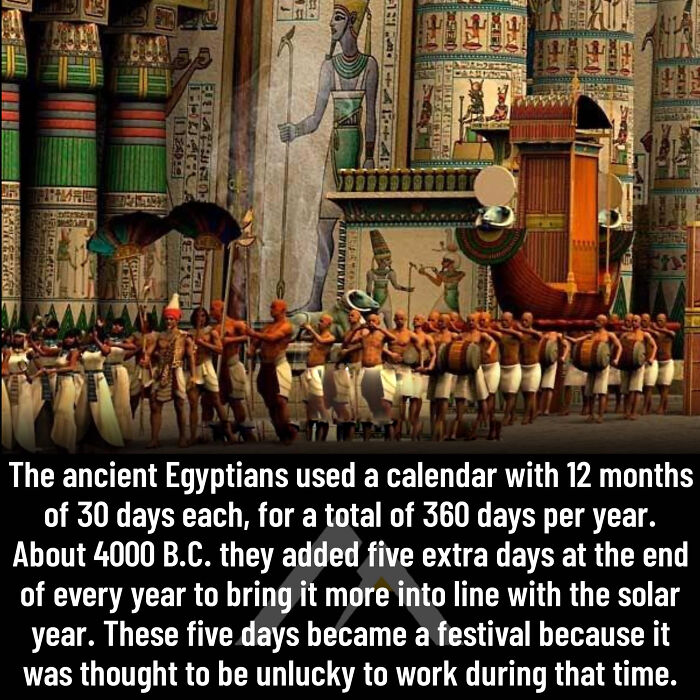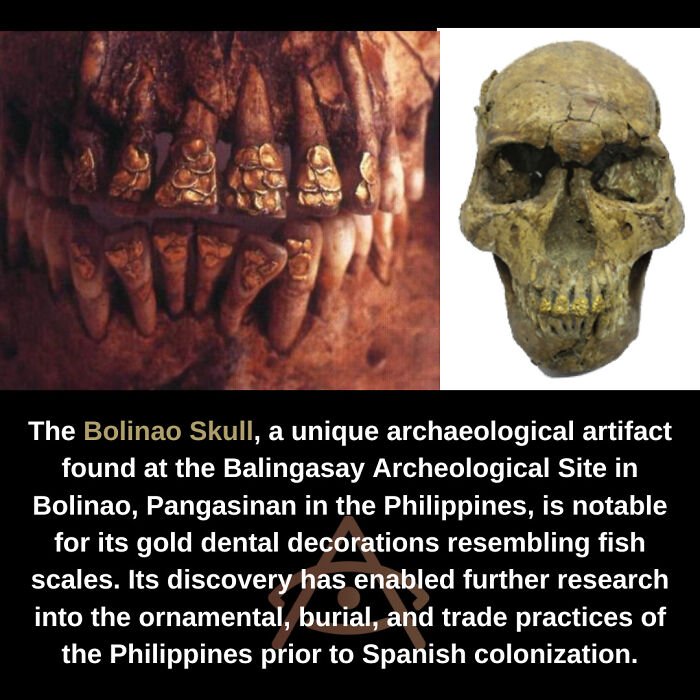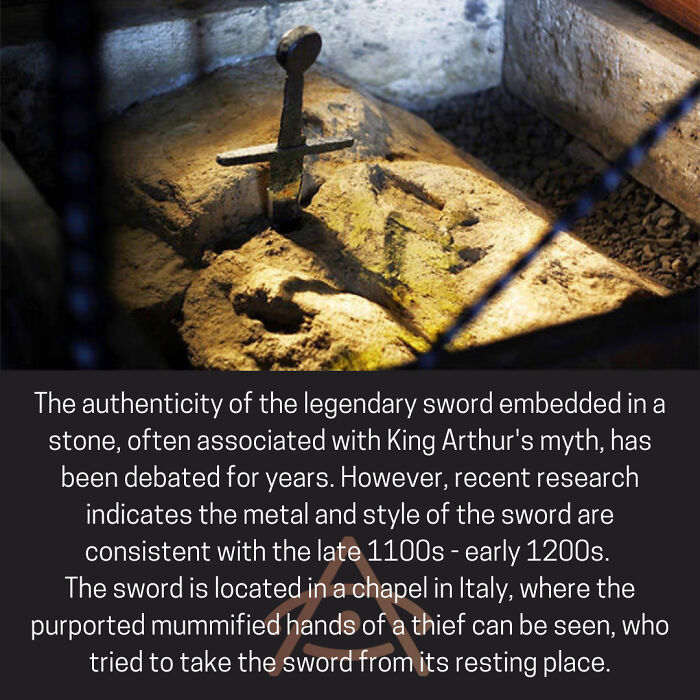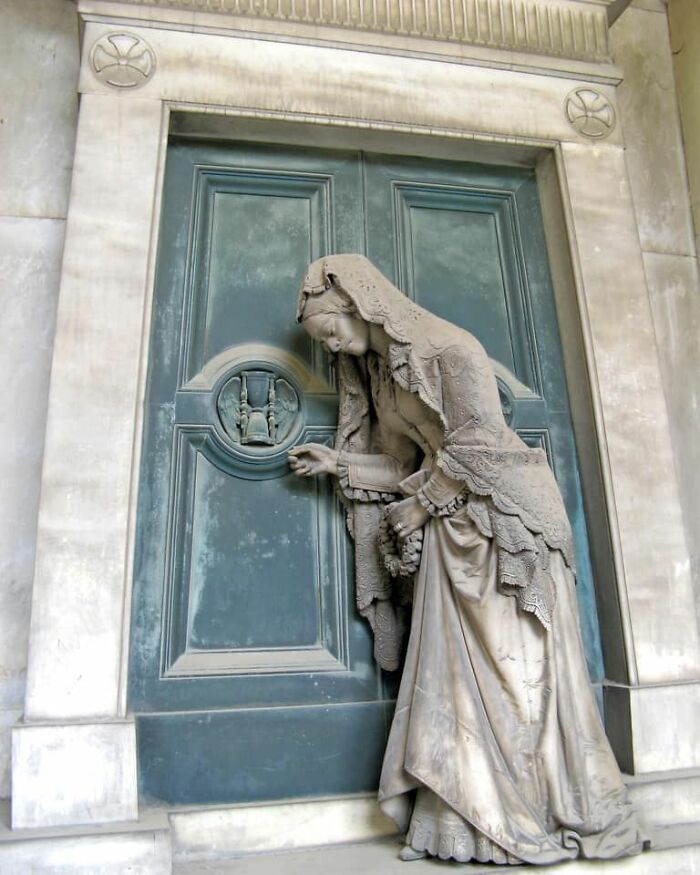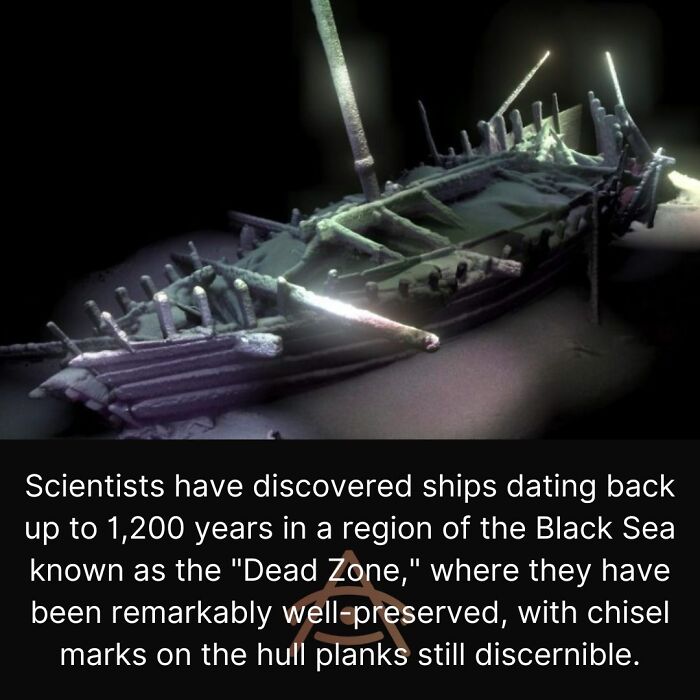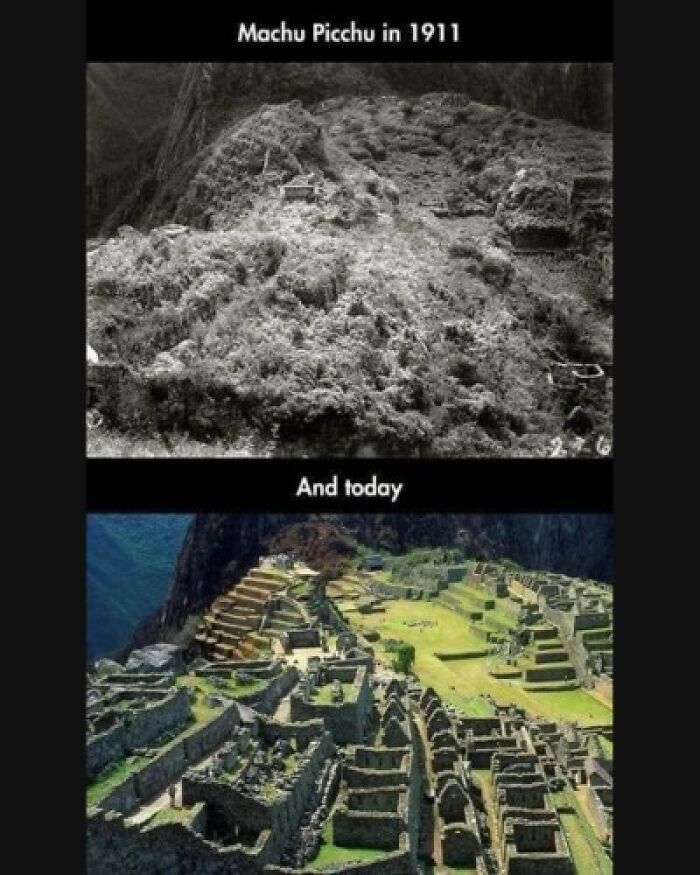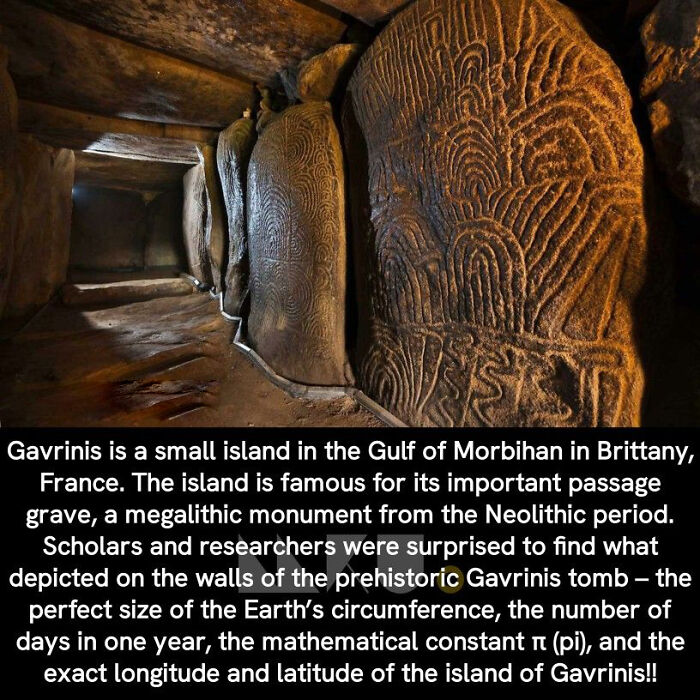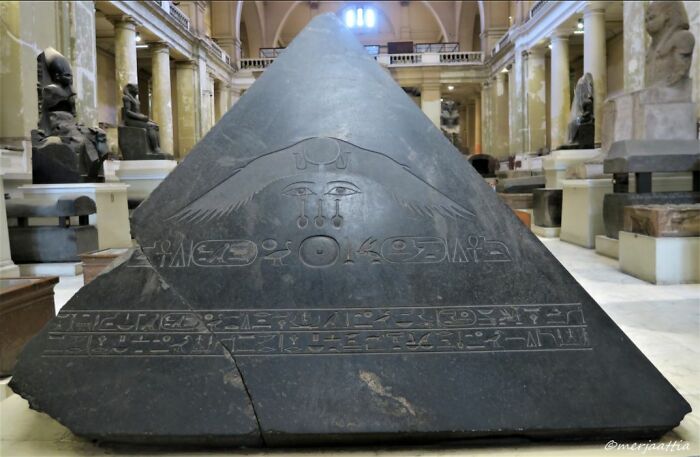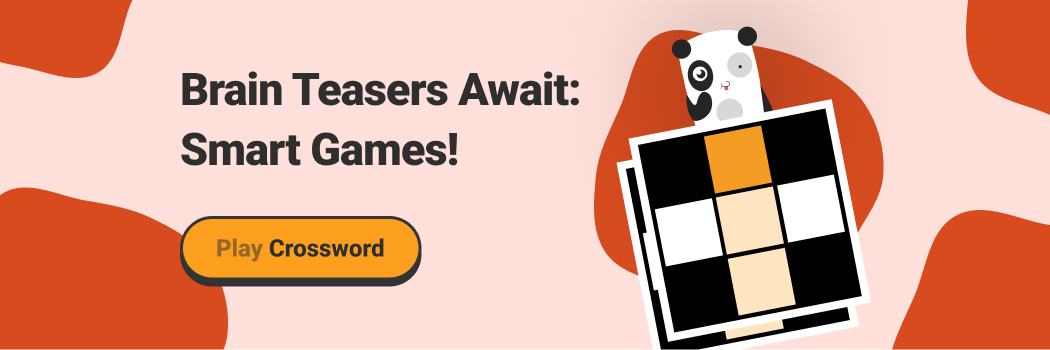
30 Fascinating Things From The Past That Survived For Future Generations To Explore, As Shared On This Facebook Group
If you’re an archaeology enthusiast, we’ve got the perfect list for you down below, pandas. We’ve taken a deep dive down the feed of Ancient Explorers on Facebook and excavated some of their most fascinating posts to share with you all.
From photos of fossils to pictures of pyramids, we hope you enjoy scrolling through this article that might give you a blast from way back in the past. Keep reading to also find conversations between Bored Panda and ancient history experts David Lee of Roman History Blog and Joanna Gillan of Ancient Origins. And feel free to underscore this list with the Indiana Jones theme song! (You can hear it now, can’t you?)
More info: AncientExplorers.com | YouTube | Instagram
This post may include affiliate links.
"Translation Of The Text Written In Gold At The Entrance To The Temple Of The Egyptian Goddess Sekhmet, Karnak Temple"
"I only ask you to enter my house with respect. To serve you I do not need your devotion, but your sincerity. Neither your beliefs, but your thirst for knowledge. Enter with your vices, your fears and your hatreds; from the greatest to the smaller ones, I can help you dissolve them. You can look at me and love me as a female, as a mother, as a daughter, as a sister, as a friend, but never look at me as an authority above yourself. If the devotion you have for any god , It is greater than the one you have for the God that is within you, you offend them both and you offend the ONE "
Cobblestones
Joshua Newlove
When we move through the world with our smartphones, heated homes, grocery stores and fancy cars, it’s easy to forget that our world has been around for literally billions of years. And while Homo sapiens, or humans, have only been here for about 300,000 years, that still leaves us with an incredible amount of history. It’s impossible to know and understand everything that humanity has been through, but thankfully, there are people out there who live for discovering more about our world’s past, and some who are even willing to share that information online.
The Ancient Explorers Facebook page writes that their mission is to “explore the history of our ancient past to make an impact on today’s and tomorrow’s,” and they certainly do a great job of that. The account, which was created on New Year’s Day in 2013, has amassed an impressive 833k followers and has posted over 10k photos. One quick scroll through the page’s feed can teach you more about fossils, ancient architecture, ancient jewelry, ancient temples and anything else that you might not have learned in history class.
This Shadow
After Undergoing Restoration Work, One Of The Most Expansive Floor Mosaics Ever Found Has Been Revealed At Hisham Palace In Jericho
The mosaic consists of 38 detailed sections that feature floral and geometric patterns made up of more than 5,000,000 stone pieces, including a 1300-year-old "tree of life."
Carlos For Scale
To learn more about why it’s so important to study our world’s past, we reached out to ancient history expert David Lee. David runs the Roman History Blog, which also has accompanying Facebook, Instagram and Twitter pages, and was kind enough to have a chat with Bored Panda about what inspired him to start studying Roman history.
“I got into Roman History as I was fascinated with Hadrian's wall as a child, and I liked visiting York, also known to the Romans as Eboracum in the North of England,” he shared. “I like the intrigue, the politics, the way the Republic changed into the rule of one man with a series of emperors. Rome expanded to encompass the Mediterranean and beyond.”
The Inscriptions That Akhenaten Left For His Wife Nefertiti On The Walls Of The Amarna Temples
"I swear by you, my God, to make her a light in my heart that will not be extinguished, and to make me a support in her back that will not be broken, for she is from me and I am from her, and we are both the secret of the existence of the other."
An essential tool that gave the Vikings the cutting edge in navigation
Lascaux
We were also curious if David could share any fun facts about Roman history that you pandas might not know, and he noted how important their legacy has been. “We still have their laws, culture, theatre, comedy, literature, buildings, military tactics and influence on the modern world."
And as far as why we should still value studying ancient history today, the history enthusiast says, “It's important to study the past so we can have a better understanding of who we are and what has happened to us and how it has influenced us in modern times.”
The Cantalloc Aqueducts, Constructed By The Nazca Civilization In The Arid Deserts Of Peru Over 1,500 Years Ago, Continue To Serve Their Purpose To This Day
These aqueducts feature distinctively shaped openings that allow wind to enter and propel water from underground aquifers through a network of underground canals, efficiently delivering water to areas where it is needed the most.
Hin Sam Wan, Also Known As Three Whale Rock
It is a stunning rock formation that is approximately 75 million years old and rises dramatically from the mountains in Thailand. Its name originates from its resemblance, when viewed from the right angle, to a family of whales, making it a unique and remarkable sight.
If you read the hitchhiker's guide you know exactly what happened there
Located At The Intersection Of Eastern Europe And Western Asia, In The Country Of Georgia, Lies The City Of Vardzia
On the slopes of Erusheti Mountain in this city, Tamar, the 25-year-old Queen of Georgia, commissioned the creation of 6,000 cave dwellings in the 12th century. These structures were carved into the rock and served as both a monastery and a place of refuge for Christian monks who were being persecuted by Mongol and Muslim invaders.
If you’d like to expand your knowledge of the ancient world but just aren’t sure where to start, David says, “There are plenty of documentaries on Youtube and other streaming sites. Also, books are a good source for learning, and we have the internet with plenty of websites with great content, including social media. I post Roman history on Twitter on a regular basis.”
“Ancient history is a fascinating subject, and you can learn so much from it. Do take the time to find out more,” he added.
If you’d like to learn more from David about the amazing history of ancient Rome, be sure to visit his blog right here!
The Arkadiko Bridge Or Kazarma Bridge In Greece Is An Astonishing 3,300-Year-Old Chariot Bridge That Is Still In Use Today
The Ancient Egyptians
At The Age Of 17, Cleopatra Became Queen Of Egypt And Ruled Until She Was 39 Years Old
She was a polyglot, as she spoke nine languages, including Ancient Egyptian and the languages of the Parthians, Hebrews, Medes, Troglodytes, Syrians, Ethiopians, and Arabs. This meant that she was able to read any book in the world.
She was also very knowledgeable in various subjects such as geography, history, astronomy, international diplomacy, mathematics, alchemy, medicine, zoology, economics, and more. Despite her many books being destroyed in a fire, some of her herbal remedies and beauty tips have survived.
Additionally, her knowledge of languages allowed her to have access to numerous papyri that are now lost. Her influence on the sciences and medicine was highly esteemed in the early centuries of Christianity, making her an unparalleled figure in human history.
1) Why the bust of Neferititi? But also Remember Egypt under the Ptolomey dynasty, she spoke Greek (their language), Egyptian (Language of the land), Persiand & Median (Languages of the next largest regional power), Aramaic (No such language as "syrian" maybe they meant the Syriac dialect of Aramaic. But Aramaic was the trade language in the region), Hebrew (an important regional language, and Alexandria had huge Jewish community, and Jews were a lot of the scholars at the time, and the powerful Judean Kingdom of the Maccabees next door was an important trade relation), Ethiopian (their southern neighbor and major trading partner), but never heard the arabic one. But it makes sense for a leader in that region to speak the most important languages at the time
I'd be amazed if any other leader could speak 9 languages. Why are you diminishing that amazing achievement.
Load More Replies...You're right, that's not a contemporary rendition of her at all.
Load More Replies...The Egyptians are upset that she was represented as Black, which she wasn't. However she wasn't ethnic Egyptian either. She was a Ptolemian Greek, the people who invaded Egypt and displaced the long dynasties of Egyptian nobility. They also took over the entire noble class, converted to Egyptian religion, and pretended to be the hereditary rulers of Egypt. Romans played along with this, and even when they conquered Egypt, they treated Greeks as the ruling class. Ethnic Egyptians were allied with the the ill-fated Jewish "Kitos Revolt", which sought an end to Roman control of the Middle East. It destroyed both the Jewish communities of Egypt and Egypts hopes for independence. Ironically, when finally Jews and Egyptians gained independence in their countries, it was as enemies. The second irony is the Israelis and Palestinians are both descendants of the Judeans and Idumeans (though Palestinians also have ancestry from other local peoples).
Um , she couldn't possibly read every book written back in the day. She didn't speak Sanskrit, Prakrit, Magadhi, Proto-Tamil, etc.
I would not count on that. Alexander the Great had roamed far into India and parts of Southern Asia just about three hundred years before, and the ptolemean dynasty took pride in being descended from one of his generals. It is safe to assume that at least some knowledge of southern and eastern asian languages did exist in Egypt at the time, especially as Alexandria was an intellectual and intercultural center. The library of Alexandria was said to also have contained buddhist and hinduist writings dating back to the alexandrine conquests.
Load More Replies...Forgot to mention that she was Queen of the Ptolemaic Kingdom of Egypt from 51 to 30 BC, and that she was a direct descendant of Ptolemy I Soter, a Macedonian Greek (general to Alexander the Great). No, she was not black, despite the colour of the marble chosen! Her full name was Κλεοπάτρα Φιλοπάτωρ, which means "The father-beloved glory of the father".
WE ALL KNOW SHE IS A MACEDONIAN GREEK. Can all you social warriors stop trying to grab up all the history. I’ve been on the Internet lately, and everybody wants to change history. Most people that are 25 and Younger don’t even know the capital of Greece or Egypt is so let’s leave it to The experts, kids.
She was incredibly intelligent, diplomatic and cunning. Most likely the reason so many powerful men were fascinated by her was her intellect. She was a tactician on par with some of the greatest in history. She was the equivalent of a chemist in her time) its theorized the "asp" that killed her was a poison of her own making rather than the serpent. But what is she known for now? Being HOT (which by all accounts she wasn't remarkable in appearance for modern or her time, likely do to the whole "family tree is a wreath" thing)
I learned a lot of new things from the comments. So googled her. Fascinating. https://www.britannica.com/biography/Cleopatra-queen-of-Egypt/Cleopatra-through-the-ages
She was also of (probably), Macedonian Greek ancestry with connections to Iran and Jordan.
it's not probable, it's definite. She was the descendant of Ptolemy I Soter, who was a Greek/Macedonian general. Her father was Ptolemy XII Neos Dionysus Philopator Philadelphus.. a very greek/macedonian name, so it's incredibly likely the greek heritage carried on. Cleopatra was also a greek name, meaning "glory of the father". Ergo, it's like.. 90% likely Cleopatra VII, aka the one we all know, was also Greek/Macedonian.
Load More Replies..."Ruled Until She Was 39 Years Old" and then, being an early follower of the FIRE movement she retired early, having invested a large portion of her earnings in the stock market of Alexandria.
Anybody can be knowledgable in history when there wasn't that much of it.
Could read any book in the world? There were numerous written languages ranging from the Indus valley to Japan that you don't mention
Upvote. She could read any book in the western world.
Load More Replies...Excuse me but, is the tone of this bust indicative or suggestive of her true color? Just wondering because of all the yahoos complaining about a recent film about Cleopatra which casts her as a woman of color... and these white supremist angry about it. just wondering.
Most of the accounts of her unattractiveness were by political rivals, especially the romans
Load More Replies...'Art uses various mediums that shouldn't be considered offensive' It's not art though is it? It's history and it's 'factual' history. I don't see a problem with anyone of different ethnicities playing roles in fiction. Bridgerton scrapes by as acceptable because it's a work of fiction but it's still based on 18th Century British upper classes. To show Cleopatra as a completely different skin colour, which effectively also states that she has incorrect origins is appropriation. You cannot have it both ways. She was Greek and she was not black. Anne Boleyn was recently played in a drama by a black woman. Again, cultural appropriation. Messing with factual history in drama is detrimental to the education of our youth. I have no idea why they even feel the need to do this.
Load More Replies...We also reached out to the ancient history experts at the website Ancient Origins to gain more insight on the topic, and we were lucky enough to get in touch with Co-Founder and Chief Editor Joanna Gillan. She explained that the site came about a decade ago when she and Dr. Ioannis Syrigos “[wanted] a project that would free [them] from the constraints of nine-to-five jobs and give [them] the flexibility to operate an online business from anywhere in the world.” They tossed around their top 10 topics, and ancient history emerged as the clear winner.
When it comes to what Joanna loves most about running Ancient Origins, she shared with Bored Panda, “I love that we’ve taken a really fun approach to ancient history, selecting the most captivating, weird, surprising, strange, shocking, or lesser-known facts from our ancient world - things like lost cities, bizarre artifacts, historical enigmas, ancient cold cases, hidden treasures, and more. By doing so, we've transformed a subject often studied in universities – which can sometimes be dry and dull – into something accessible and engaging for everyone, reigniting the public's enthusiasm for the mysteries and fascination of our distant past.”
For 3245 Years
The Diary Of Merer
Pumapunku
Joanna also shared that her absolute favorite topic to study in ancient history is the Sumerians, whose amazingly advanced civilization seemed to just spring up out of nowhere in what is now Iraq. “Suddenly, around 6,000 years ago, they jumped from being hunter gatherers and then simple agricultural communities to establishing one of the world’s first civilizations," she explained. "They developed intricate writing systems, an advanced justice system, a complex social structure, well-organized cities, incredible art, literature, and architecture, sophisticated timekeeping and mathematics, and a rich mythology and religion. It is quite mind-boggling!”
The Bolinao Skull
Petrified Forest National Park
A Hug That Lasts 2000 Years, Pompeii
In 79 AD, the city was destroyed and buried under volcanic ash and pumice during the eruption of Mount Vesuvius. The catastrophic event resulted in the death of many of its inhabitants who were buried beneath the ash and debris.
However, the volcanic ash and pumice that destroyed Pompeii also acted as a preservative, protecting many of the city's buildings, artifacts, and even some of the human remains from decay. As a result, much of the city has been remarkably well-preserved, providing a unique glimpse into the daily life and culture of ancient Rome.
Joanna was also kind enough to share some fascinating fun facts about ancient history with us. “The earliest dentures were made with teeth scavenged from dead soldiers. In ancient China, they used armor made from layers and layers of paper, and in some instances, it was deemed superior to metal armor. Romans wore red-crested helmets in battle to prevent them killing people on their side,” she noted.
“In 16th-17th Britain, pineapples were a status symbol and people would pay thousands for one pineapple. They could even rent them by the hour to display at a dinner party. For 1,000 years, monks of Mt Athos in Greece have not only banned women, but also female animals,” Joanna continued. “Mary, Queen of Scots, washed with white wine to ensure a smooth complexion. Queen Elizabeth I may have died from wearing toxic lead-based makeup. Ketchup originated in ancient China. Eels were sometimes used to pay rent in the Middle Ages. Tutankhamun’s parents were brother and sister.”
This Shipwreck
That's a 2,000 year old wheelhouse, is it? There's probably a 2,000 year old diesel engine, too.
Belize
That's Old
When it comes to why it’s so important that we study ancient history, Joanna says, “[It] offers a window into our very origins – unraveling the birth of mankind and our evolution through the development of civilization, culture, society, and religion. Delving into the history of ancient societies gives us the opportunity to glean wisdom from their successes and failures, thus informing our modern lives. As the renowned Spanish philosopher George Santayana aptly noted, ‘Those who cannot remember the past are condemned to repeat it.’ While historical lessons may not always ward off doom and disaster, learning about them can help us better understand our present and also anticipate our future.”
And if you’d like to learn more about ancient history, Joanna says it’s best to get out in the field. “Visit ancient sites, talk to locals who know lesser-known facts, folklore and historical tidbits, visit museums, join tours and expeditions. You can even volunteer to participate in archaeological digs to gain hands-on experience. These adventures can help you nurture your passion and identify your specific areas of interest.”
The "Ringed" Lady
Damn
"To those holdinth the Disc of Infinite Power... Can Thy throw it further than Thy Buddies and also Drinkingfriends? Show Thyne worth with the Powerful Frith-bee"
Legendary Sword
Joanna also shared a fascinating story detailing how exciting studying ancient history can be. “In 2015, Ioannis and I were in Ecuador investigating the lost artifacts of Father Crespi, an Italian missionary who had spent 60 years there since the 1930s. He had done a lot of good work, and in return, the indigenous people brought him artifacts from all over the country, ranging from 200 to 2,000 years old and covering various cultures and ages,” she explained.
“Among these artifacts, there was a controversial subset depicting Sumerian writing, gods, and figurines. If authentic, it would imply contact between Sumer (now Iraq) and South America thousands of years ago, which is not mentioned in history books.”
“However, the controversial artifacts went missing, and we wanted to find out where they went,” Joanna continued. “We gained exclusive access to Crespi’s artifact collection in Ecuador's central bank vaults, but the Sumerian ones were missing. Upon inquiring about them, we received threats and were told not to ask about the missing artifacts and to take our investigations elsewhere. Later, we were threatened with legal action if we were to write an article about the missing artifacts.”
A Golden Ring Dating Back To The 4th Century Bc Was Discovered In The Tomb Of A Thracian King Located In The Yambol Region Of Bulgaria
This archaeological find sheds light on the craftsmanship and artistic traditions of the Thracians, an ancient people who inhabited the Balkans from the 5th century BC to the 6th century AD. The Thracians were known for their rich cultural heritage, which included elaborate burial rituals and intricate metalwork.
The discovery of the golden ring in the Thracian king's tomb underscores the importance of jewelry in Thracian society, and it serves as a testament to the skill of Thracian artisans. It also provides valuable insights into the social hierarchy and status symbols of the ancient Thracians, as the ring was likely worn by a member of the ruling class.
Overall, the discovery of the 4th century BC golden ring in the Yambol region of Bulgaria is a significant archaeological find that enriches our understanding of ancient Thracian culture and history.
w/out "robbing graves" you wouldn't even know this amazing part of history even existed...enjoy the info and pictures
“In 2016, Ioannis and a colleague, Gary, were investigating a story for Ancient Origins on the Tayos Caves in Ecuador, a vast underground network where several ancient artifacts have been recovered in the past, but many parts of the cave remain untouched and unexplored,” Joanna shared. “Like something out of an Indiana Jones episode, they were captured by a machete-wielding tribe in the Amazon jungle for accidentally straying into their territory. They were taken back to the village and put on trial. The villagers voted that they were guilty, but Ioannis and Gary managed to talk and pay their way out of it, before being left in the jungle in the middle of the night. So, a website on ancient history is not all dusty academic articles and artifacts!”
If you’d like to learn more about ancient history, be sure to visit AncientOrigins.net right here!
Great Zimbabwe Refers To The Stone Ruins Of A Historic City Situated Near Present-Day Masvingo, Zimbabwe
Archaeological studies suggest that the central ruins and the adjacent valley were home to a Shona community of 10,000 to 20,000 people. This city was the focal point of a prosperous trading empire spanning from the 11th to the 15th centuries. Its economy was primarily based on cattle farming, crop cultivation, and the export of gold to the Indian Ocean coastline. The Kingdom of Zimbabwe, an influential Shona trading empire, had its capital in this city, which is named after the Shona phrase for "stone houses."
We hope you’re enjoying this virtual trip to an ancient history museum, pandas. Whether you’ve studied archeology yourself or you didn’t realize that dinosaurs and humans never coexisted, we hope you’ve been able to learn something new here today. Feel free to share any other fun facts about ancient history that you know down below, and keep upvoting the images you find most captivating! Then, if you’re interested in reading another Bored Panda article featuring artifacts that have been preserved for many years, check out this story next!
German Oath Skull
Love the discoveries. Speculation on what it was or what it was used for. Imagine in 500 years they dig up the red balls in front of the Target store and try to explain those.
I think that the discovery of Legoland will raise a lot of questions
Load More Replies...Lot of new knowledge has be acqired to add to the current age fast advancing world.
Did they include the Ancient Egyptian NUCLEAR WAR as a troll or has BP just gotten THAT ludicrous
This collection furthers my belief that we, as the human race, are devolving rather than evolving. Looks like the people of ancient times were a whole lot smarter than we are today. In my opinion we are barreling towards an Idiocracy as portrayed in the movie of the same name.
Love the discoveries. Speculation on what it was or what it was used for. Imagine in 500 years they dig up the red balls in front of the Target store and try to explain those.
I think that the discovery of Legoland will raise a lot of questions
Load More Replies...Lot of new knowledge has be acqired to add to the current age fast advancing world.
Did they include the Ancient Egyptian NUCLEAR WAR as a troll or has BP just gotten THAT ludicrous
This collection furthers my belief that we, as the human race, are devolving rather than evolving. Looks like the people of ancient times were a whole lot smarter than we are today. In my opinion we are barreling towards an Idiocracy as portrayed in the movie of the same name.

 Dark Mode
Dark Mode 

 No fees, cancel anytime
No fees, cancel anytime 
















